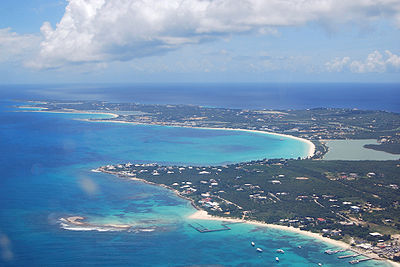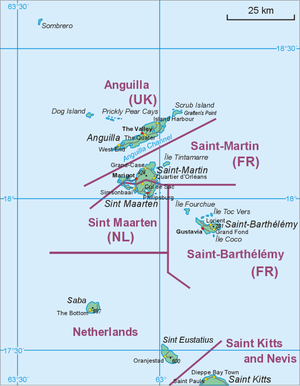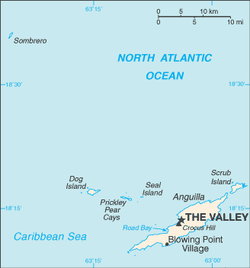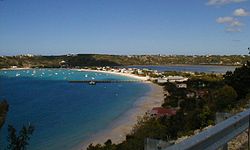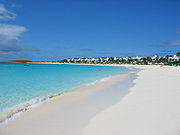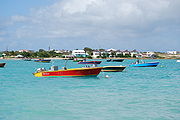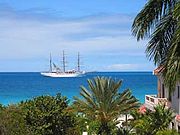
Anguilla
About this schools Wikipedia selection
This wikipedia selection has been chosen by volunteers helping SOS Children from Wikipedia for this Wikipedia Selection for schools. Click here to find out about child sponsorship.
| Anguilla | ||||||
|---|---|---|---|---|---|---|
|
||||||
| Motto: "Strength and Endurance" | ||||||
| Anthem: God Save the Queen National song: God Bless Anguilla 1 |
||||||
|
|
||||||
| Capital | The Valley | |||||
| Official languages | English | |||||
| Ethnic groups | 90.1% West African, 4.6% Multiracial, 3.7% European, 1.5% other | |||||
| Demonym | Anguillian | |||||
| Government | British Overseas Territory | |||||
| - | Monarch | HM Queen Elizabeth II | ||||
| - | Governor | William Alistair Harrison | ||||
| - | Deputy Governor | Stanley Reid | ||||
| - | Chief Minister | Hubert Hughes | ||||
| Establishment | ||||||
| - | UK overseas territory | 1980 | ||||
| Area | ||||||
| - | Total | 91 km2 ( 220th) 35 sq mi |
||||
| - | Water (%) | negligible | ||||
| Population | ||||||
| - | 2006 estimate | 13,600 ( 212th) | ||||
| - | Density | 132/km2 ( n/a) 342/sq mi |
||||
| GDP ( PPP) | 2004 estimate | |||||
| - | Total | $108.9 million | ||||
| - | Per capita | $8,800 | ||||
| Currency | East Caribbean dollar ( XCD) |
|||||
| Time zone | ( UTC-4) | |||||
| Drives on the | left | |||||
| Calling code | +1-264 | |||||
| ISO 3166 code | AI | |||||
| Internet TLD | .ai | |||||
| 1. | "National Song of Anguilla". Official Website of the Government of Anguilla. http://www.gov.ai/national_song.htm. Retrieved 12 October 2005. | |||||
Anguilla (pronounced /æŋˈɡwɪlə/ ang-GWIL-ə) is a British overseas territory in the Caribbean, one of the most northerly of the Leeward Islands in the Lesser Antilles. It consists of the main island of Anguilla itself, approximately 26 km (16 mi) long by 5 km (3.1 mi) wide at its widest point, together with a number of much smaller islands and cays with no permanent population. The island's capital is The Valley. The total land area of the territory is 91 km2 (35 sq mi), with a population of approximately 13,500 (2006 estimate). It lies east of Puerto Rico and the Virgin Islands and directly north of Saint Martin.
History
Anguilla was first settled by Amerindian tribes who migrated from South America. The earliest Amerindian artifacts found on Anguilla have been dated to around 1300 BC, and remains of settlements date from 600 AD. The date of European discovery is uncertain: some sources claim that Columbus sighted the island in 1493, while others state that the island was first discovered by the French in 1564 or 1565. The name Anguilla derives from the word for "eel" in any of various Romance languages (modern Spanish: anguila; French: anguille; Italian: anguilla), probably chosen because of the island's eel-like shape.
Anguilla was first colonised by English settlers from Saint Kitts, beginning in 1650. The French temporarily took over the island in 1666 but under the Treaty of Breda it was returned to English control. In this early colonial period Anguilla sometimes served as a place of refuge. A Major John Scott who visited in September of 1667 wrote of leaving the island "in good condition" and noted that in July 1668 "200 or 300 people fled thither in time of war." Other early arrivals included Europeans from Antigua and Barbados. It is likely that some of these early Europeans brought enslaved Africans with them. Historians confirm that African slaves lived in the region in the early seventeenth century. For example, Africans from Senegal lived in St. Christopher (today St. Kitts) in 1626. By 1672 a slave depot existed on the island of Nevis, serving the Leeward Islands. While the time of African arrival in Anguilla is difficult to place precisely, archival evidence indicates a substantial African presence (at least 100) on the island by 1683.
While traditional histories of the region assume that "the English" were the first settlers of Anguilla under British rule, recent scholarship focused on Anguilla offers a more nuanced view. It emphasizes the significance of early sociocultural diversity. This research suggests that St. Christopher, Barbados, Nevis and Antigua are all significant points of origin. Regarding African origins, West Africa as well as Central Africa are both posited as the ancestral homelands of some of Anguilla's early African population.
During the early colonial period, Anguilla was administered by the British through Antigua, but in 1824 it was placed under the administrative control of nearby Saint Kitts. In 1967, Britain granted Saint Kitts and Nevis full internal autonomy, and Anguilla was also incorporated into the new unified dependency, named Saint Christopher-Nevis-Anguilla, against the wishes of many Anguillians. This led to two rebellions in 1967 and 1969 ( Anguillian Revolution), headed by Ronald Webster, and a brief period as a self-declared independent republic. British authority was fully restored in July, 1971. In 1980 Anguilla was finally allowed to secede from Saint Kitts and Nevis and become a separate British colony (now termed a British overseas territory).
Politics
Anguilla is an internally self-governing overseas territory of the United Kingdom. Its politics take place in a framework of a parliamentary representative democratic dependency, whereby the Chief Minister is the head of government, and of a pluriform multi-party system.
The United Nations Committee on Decolonization includes Anguilla on the United Nations list of Non-Self-Governing Territories. The territory's constitution is Anguilla Constitutional Order 1 April 1982 (amended 1990). Executive power is exercised by the government. Legislative power is vested in both the government and the House of Assembly. The Judiciary is independent of the executive and the legislature.
Military
As a dependency of the UK, the UK is responsible for its military defence, although there are no active garrison or armed forces present.
Geography
Anguilla is a flat, low-lying island of coral and limestone in the Caribbean Sea, east of Puerto Rico and the Virgin Islands. It is directly north of Saint Martin, separated from that island by the Anguilla Channel. The soil is generally thin and poor, supporting only scrub vegetation.
Anguilla is noted for its spectacular and ecologically important coral reefs and beaches. Apart from the main island of Anguilla itself, the territory includes a number of other smaller islands and cays, mostly tiny and uninhabited. Some of these are:
- Anguillita
- Dog Island
- Prickly Pear Cays
- Sandy Island
- Scrub Island
- Scilly Cay
- Seal Island
- Sombrero, also known as Hat Island
Climate
Temperature
Northeastern trade winds keep this tropical island relatively cool and dry. Average annual temperature is 27 °C (80.6 °F). July–October is its hottest period, December–February, its coolest.
Rainfall
Rainfall averages 900 mm (35.4 in) annually, although the figures vary from season to season and year to year. The island is subject to both sudden tropical storms and hurricanes, which occur in the period from July to October. The island suffered damage in 1995 from Hurricane Luis.
Economy
Anguilla's thin arid soil is largely unsuitable for agriculture, and the island has few land-based natural resources. Its main industries are tourism, offshore incorporation and management, offshore banking, and fishing. Many insurance and financial business are headquartered in Anguilla.
The economy of Anguilla is expanding rapidly, especially the tourism sector which is driving major new developments in partnerships with multi-national companies. This boom, beginning gently during 2005–2006, is accelerating through 2007 and is expected to continue for years.
Anguilla's currency is the East Caribbean dollar, though the US dollar is also widely accepted. The exchange rate is fixed to the US dollar at US$1 = EC$2.68.
The economy, and especially the tourism sector, suffered a setback in late 1995 due to the effects of Hurricane Luis in September but recovered in 1996. Hotels were hit particularly hard during this time. Another economic setback occurred during the aftermath of Hurricane Lenny in 2000.
Transportation
Anguilla is served by Clayton J. Lloyd International Airport (prior to 4 July 2010 known as Wallblake Airport). The primary runway at the airport is 5,462 feet (1,665 m) in length and can accommodate moderate-sized aircraft. Services connect to various other Caribbean islands, but the airport can receive large jets such as Boeing 757 and there are no direct flights to or from continental America or Europe. Regular ferries link Anguilla and the neighboring island of Saint Martin, with a journey time of about twenty minutes.
Aside from taxis, there is no public transport on the island. Cars drive on the left.
Demographics
The majority of residents (90.08%) are black, the descendants of slaves transported from Africa. Growing minorities include whites at 3.74% and people of mixed race at 4.65% (figures from 2001 census).
72% of the population is Anguillian while 28% is non-Anguillian (2001 census). Of the non-Anguillian population, many are citizens of the United States, United Kingdom, St Kitts & Nevis, the Dominican Republic, Jamaica and Nigeria.
2006 and 2007 saw an influx of large numbers of Chinese, Indian, and Mexican workers, brought in as labour for major tourist developments due to the local population not being large enough to support the labour requirements.
Culture
The Anguilla National Trust (ANT) was established in 1988 and opened its offices in 1993 charged with the responsibility of preserving the heritage of the island, including its cultural heritage. The Trust has programmes encouraging Anguillian writers and the preservation of the island's history.
The island's cultural history begins with the Taino Indians. Artifacts have been found around the island, telling of life before European settlers arrived.
As throughout the Caribbean, holidays are a cultural fixture. Anguilla's most important holidays are of historic as much as cultural importance – particularly the anniversary of the emancipation (previously August Monday in the Park), celebrated as the Summer Festival. British festivities, such as the Queen's birthday, are also celebrated.
Religion
According to the 2001 census Christianity is Anguilla's predominant religion, with 29 percent of the population practising Anglicanism. Another 23.9 percent are Methodist. Other churches on the island include Seventh-day Adventist, Baptist, Roman Catholic, and Jehovah's Witnesses (0.7%). Between 1992 and 2001 the number of followers of the Church of God and Pentecostal Churches increased considerably. There are at least fifteen churches on the island, several of architectural interest. Although a minority on the island, it is an important location to followers of Rastafarian religion – Anguilla is the birthplace of Robert Athlyi Rogers, author of The Holy Piby which has had a strong influence on Rastafarian beliefs. Various other religions are practised as well.
| Religion | 1992 | 2001 |
|---|---|---|
| Anglican | 40.4 | 29.0 |
| Methodist | 33.2 | 23.9 |
| Seventh-day Adventist | 7.0 | 7.6 |
| Baptist | 4.7 | 7.3 |
| Roman Catholic | 3.2 | 5.7 |
| Episcopalian | - | 7.6 |
| Pentecostal | - | 7.7 |
| Jehovah Witnesses | - | 0.7 |
| Rastafarian | - | 0.7 |
| Evangelical | - | 0.5 |
| Plymouth Brethren | - | 0.3 |
| Muslim | - | 0.3 |
| Presbyterian | - | 0.2 |
| Hindu | - | 0.4 |
| Jewish | - | 0.1 |
| None | - | 4.0 |
| Other | 10.7 | 3.5 |
| Not stated | 0.7 | 0.3 |
Language
Today most people in Anguilla speak a British-influenced variety of "Standard" English. Other languages are also spoken on the island, including varieties of Spanish, Chinese and the languages of other immigrants. However, the most common language other than Standard English is the island's own English-lexifier Creole language (not to be confused with French Creole spoken in islands such as Haiti, Martinique, and Guadeloupe). It is referred to locally by terms such as "dialect" (pronounced "dialek"), or "Anguillian". It has its main roots in early varieties of English and West African languages, and is similar to the dialects spoken in English-speaking islands throughout the Eastern Caribbean.
Linguists who are interested in the origins of Anguillian and other Caribbean Creoles point out that some of its grammatical features can be traced to African languages while others can be traced to European languages. In order to understand how this works it is useful to remember that grammatical "features" consists of much more than words (i.e., lexical items). It is possible that different aspects of this language have different origins and influences. The aspects that should be considered in understanding the history of the grammar of this language are at least 5: semantics (meaning); phonology (the system of consonants and vowels characteristic of a given language), syntax (word order), and morphology (rules for forming words).
What language are these early Africans likely to have spoken? Three areas have been identified as significant for the identification of the linguistic origins of those forced migrants who arrived before 1710: the Gold Coast, the Slave Coast, and the Windward Coast.
Sociohistorical information from Anguilla's archives suggest that Africans and Europeans formed two distinct, but perhaps overlapping speech communities in the early phases of the island's colonization. "Anguillian" is believed to have emerged as the language of the masses as time passed, slavery was abolished, and locals began to see themselves as "belonging" to Anguillian society.
Music
Sport
Boat racing has deep roots in Anguillian culture, and is the national sport. There are regular sailing regattas on national holidays, such as Carnival, which are contested by locally built and designed boats. These boats have names and have sponsors that print their logo on their sails.
As in many other former British Colonies, cricket is also a popular sport. Anguilla is the home of Omari Banks, who played for the West Indies Cricket Team, while Cardigan Connor played first-class cricket for English county side Hampshire and was 'chef de mission' (team manager) for Anguilla's Commonwealth Games team in 2002.
Rugby union is represented in Anguilla by the Anguilla Eels RFC, who were formed in April 2006. The Eels have been finalists in the St. Martin tournament in November 2006 and semi finalists in 2007, 2008, and 2009. The Eels were formed in 2006 by Scottish club national second row Martin Welsh, Club Sponsor and madame President of the AERFC Ms Jacquie Ruan, and Canadian standout Scrumhalf Mark Harris (Toronto Scottish RFC). The club was lucky enough to host the HMS Iron Duke in September 2008 which saw a very spirited game going to the visitors 18-13. The St Barts Barracudas have also been to Anguilla to play the Eels also prevailing 11 tries to 6.




